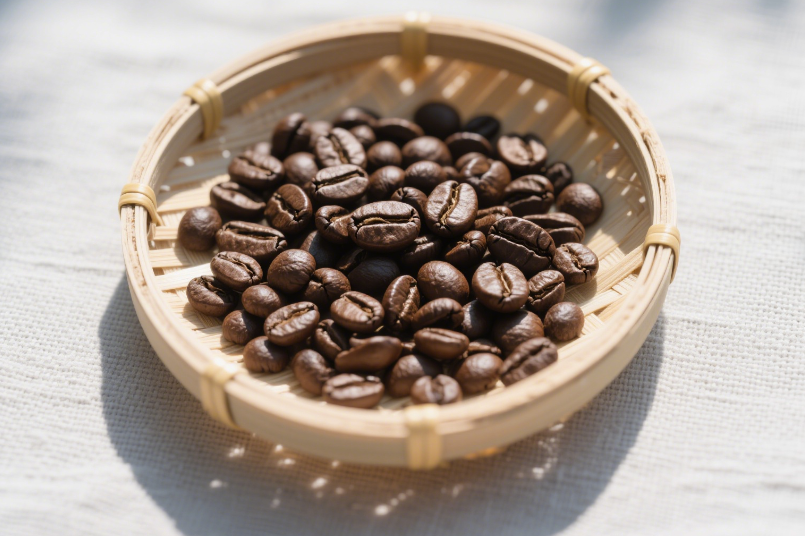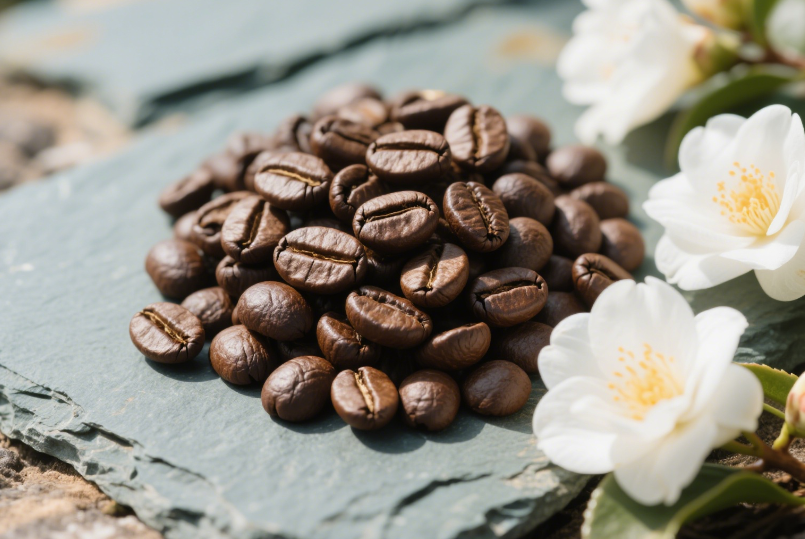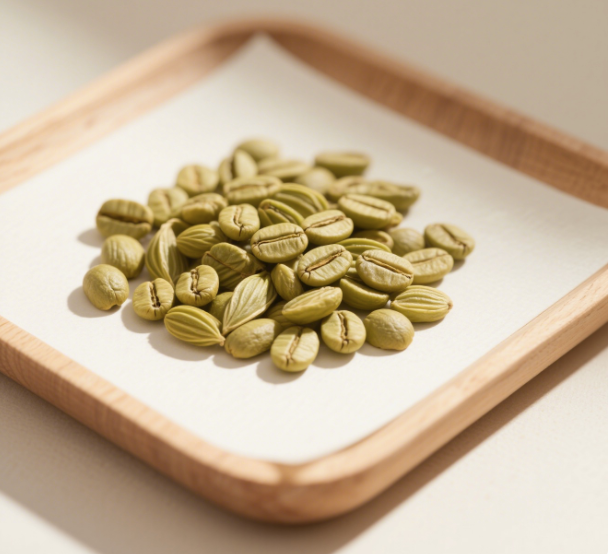
BAMBOO TEA
August 22, 2025
OSMANTHUS TEA
August 22, 2025QINGSHAN COFFEE BEANS
$148.80
Qingshan coffee beans, a distinctive member of the Arabica family, have been gaining increasing recognition in recent years, captivating coffee enthusiasts around the globe. Primarily cultivated in the Qingshan region of Yunnan, China, these beans benefit from the area’s exceptional natural environment, which provides ideal conditions for their growth, endowing them with unique flavors and superior quality.
Origin and Development
The cultivation history of Qingshan coffee beans dates back to the end of the 20th century, a time when the coffee – growing industry was beginning to take root in Yunnan. Local farmers introduced Arabica coffee varieties, and through years of meticulous cultivation and adaptation to the specific climatic and soil conditions of the Qingshan area, the distinctive Qingshan coffee beans we know today were developed. Initially, the cultivation was on a small scale, with most farmers growing them sporadically. However, as the demand for high – quality coffee beans in the market grew, Qingshan coffee beans, with their unique flavor, gradually attracted attention, leading to a steady expansion of the cultivation scale.
Growing Environment
The Qingshan region is situated at an altitude ranging from 1200 to 1800 meters. This elevation results in a significant temperature difference between day and night. The warm sunlight during the day promotes photosynthesis, while the cool nights slow down the ripening of the coffee cherries, facilitating the accumulation of flavor – enhancing substances. The annual average temperature here is between 18 and 22°C, and the area receives abundant rainfall, with an annual precipitation of approximately 1500 to 2000 millimeters, providing sufficient moisture for the growth of coffee trees. The soil is mainly fertile red soil and yellow soil, rich in minerals and with good drainage, creating an excellent environment for the growth of coffee tree roots and the absorption of nutrients. Moreover, the high forest coverage in the Qingshan region acts as a natural ecological barrier, not only providing a suitable microclimate for the coffee trees but also reducing the incidence of pests and diseases, enabling coffee cultivation to be carried out in a relatively natural and eco – friendly manner.
Flavor Characteristics
Qingshan coffee beans boast a rich and charming flavor profile. In terms of aroma, they emit a fresh floral scent, reminiscent of jasmine and gardenia, along with a hint of citrus fruit aroma, such as lemon and orange, presenting distinct and long – lasting layers of fragrance. Upon tasting, the first thing that strikes you is a bright acidity, similar to the refreshing tang of green apples and grapefruits. This acidity is lively yet not harsh, intermingling with a mellow sweetness. The sweetness leans towards the pleasant taste of honey and caramel, gentle and delicate. In terms of mouthfeel, it has a medium body, with a smooth texture that spreads across the palate like silk, accompanied by a subtle nutty flavor, such as the aftertaste of almonds, adding complexity to the overall flavor. The aftertaste lingers with the floral and fruity aromas, leaving a clean and enduring finish that makes you crave more.
Cultivation Traits
- Growth Cycle: The growth cycle of Qingshan coffee beans is relatively long. From the blooming of the coffee flowers to the ripening of the fruits, it takes about 9 to 11 months. This extended growth period allows the fruits ample time to accumulate sugars and flavor compounds, which is one of the key reasons for their rich and complex flavor.
- Pest and Disease Resistance: As an Arabica variety, Qingshan coffee beans have relatively weak resistance to pests and diseases, being susceptible to infestations such as coffee leaf rust and coffee fruit flies. Therefore, local farmers adopt green pest control techniques, such as releasing natural enemies of the pests and setting up traps, to reduce the use of chemical pesticides, ensuring the quality of the coffee beans and the sustainability of the ecological environment.
- Balance between Yield and Quality: To ensure the high quality of the coffee beans, farmers strictly control the number of fruits on each coffee tree. Through proper pruning and fruit thinning, they concentrate the nutrient supply to each tree, achieving a balance between yield and quality. Although the yield is relatively low, each coffee bean is packed with abundant flavor.
Processing Methods
- Washed Process: After harvesting, the coffee cherries are first sorted to remove unripe and defective ones. Then, the beans are separated from the pulp using mechanical peeling. The shelled beans are then placed in fermentation tanks for 12 to 24 hours of fermentation to remove the remaining pectin. After that, they are thoroughly washed to ensure the surface of the beans is clean, and then dried on sun – drying beds or using mechanical dryers until the moisture content reaches 10% to 12%. Qingshan coffee beans processed using the washed method have bright acidity, a fresh taste, and more prominent floral and fruity notes.
- Natural Process: The sorted coffee cherries are directly placed on special drying racks and exposed to the sun for 10 to 15 days, with regular turning to ensure even drying. This processing method allows the beans to fully absorb the sun’s energy, and the sugars in the cherries undergo natural transformation during the drying process, giving the coffee beans a more intense fruity aroma and a mellow sweetness, with a fuller body and rich flavor layers.
- Honey Process: After partially removing the pulp of the coffee cherries, a certain proportion of the pectin layer is retained, and the beans with pectin are dried. Depending on the amount of pectin retained, it is divided into yellow honey, red honey, and black honey processing. Qingshan coffee beans processed using the honey method have both the bright acidity of the washed process and the mellow sweetness of the natural process, along with a unique honey – like sweetness, a round mouthfeel, and a complex and balanced flavor.
Brewing Suggestions
- Pour – over: Use Qingshan coffee beans ground to a medium – fine consistency, similar to granulated sugar. The water temperature should be controlled at 88 to 92°C, and the coffee – to – water ratio is 1:15 to 1:16. First, use a small amount of hot water to bloom the coffee grounds for about 30 seconds to release the aroma, then slowly and evenly pour water in a circular motion, with the total brewing time controlled within 2 to 3 minutes. Pour – over brewing can fully bring out the floral, fruity, and bright acidic notes of Qingshan coffee beans, with a fresh taste and rich layers.
- Siphon: Grind the coffee beans to a medium fineness, and heat the water to 90 to 92°C. Using a coffee – to – water ratio of 1:12 to 1:13, first pour water into the lower chamber. When the water boils, insert the upper chamber into the lower one. Due to the siphon principle, the water in the lower chamber rises to the upper chamber. At this point, add the coffee grounds, stir evenly, extract for 1 to 1.5 minutes, then remove the heat source, and the coffee liquid in the upper chamber will flow back to the lower chamber. Coffee brewed with a siphon has a mellow taste, which can well preserve the nutty flavor and sweetness of the coffee beans, with a strong aroma.
- Espresso: The coffee beans need to be ground into an extremely fine powder, close to the fineness of flour. Use water at 92 to 94°C, with 18 to 22 grams of coffee powder, and extract under 9 to 10 atmospheres of pressure for 25 to 30 seconds to obtain 30 to 40 milliliters of espresso. Espresso can highlight the mellow taste and rich crema of Qingshan coffee beans, and their balanced sweet and sour flavor is more intense in the concentrated form, making them an excellent base for making lattes, cappuccinos, and other milk – based coffees.
Storage and Freshness
To maintain the freshness and optimal flavor of Qingshan coffee beans, they should be stored in airtight, light – proof containers, away from heat sources and moisture. Unopened coffee beans can be stored at room temperature for 1 to 2 months, and once opened, it is recommended to consume them within 2 to 3 weeks. Ground coffee powder has a larger surface area in contact with air, so it oxidizes more quickly and should be used as soon as possible. If you can’t use it all at once, you can seal it and store it in the refrigerator, but be careful to avoid absorbing odors, and let it return to room temperature before use to avoid affecting the brewing result.
With their unique flavor, careful cultivation, and processing, Qingshan coffee beans have become a shining new star in the coffee world. Every cup of coffee brewed from Qingshan coffee beans carries the sunshine, rain, and local customs of the Qingshan area in Yunnan, offering coffee lovers a unique and wonderful taste experience.
Category: COFFEE BEANS
| Weight | 0.5 kg |
|---|
Store
Price
Details
General Inquiries
There are no inquiries yet.








